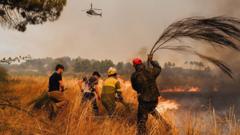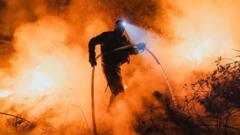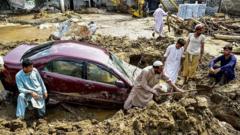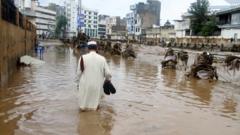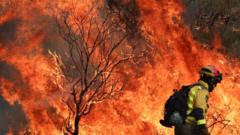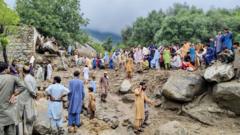**The WHO emphasizes that without immediate adaptation strategies, extreme heat may compromise health and productivity for millions of employees worldwide.**
**WHO Issues Urgent Call for Workplace Heat Protection as Climate Change Intensifies**
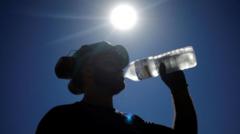
**WHO Issues Urgent Call for Workplace Heat Protection as Climate Change Intensifies**
**New report highlights the increasing risks of heat stress for workers globally, urging systems to adapt.**
The World Health Organization (WHO) has raised alarms about heat-related risks for workers due to escalating climate change, particularly affecting construction and agricultural sectors. According to a new report developed in collaboration with the World Meteorological Organization, millions of employees are at heightened risk of heat stress, significantly impairing their health and work output. The report serves as a clarion call for collaboration among governments, employers, and laborers to devise effective adaptation measures.
This marks the WHO's first comprehensive analysis on workplace heat stress since 1969. Dr. Rüdiger Krech, WHO's director for environment, climate, and health, remarked, “This is not merely a case of discomfort; it poses a genuine health threat.” It highlights that prolonged exposure to temperatures exceeding 38C can lead to severe conditions such as heat-related strokes, kidney failures, and dehydration.
The report indicates a worrying trend, as heatwaves are becoming more frequent and relentless. The last decade has recorded the highest temperatures ever, with predictions stating that 2024 could break previous records. For instance, parts of Europe have increasingly witnessed temperatures surpassing 40C (104F), while regions like Africa can reach extreme highs of up to 50C. The Mediterranean region is also facing unprecedented warming, registering average surface temperatures of 26.68C in July.
The ramifications extend beyond health concerns, with productivity suffering as temperatures rise. Research cited within the report notes a reduction in work efficiency, with a decrease of 2% for every degree Celsius above 20C. Furthermore, a Swiss insurance study revealed that the likelihood of workplace accidents can surge by 7% under temperatures over 30C, due in part to diminished concentration levels and fatigue.
Governments are beginning to address these challenges. Italy's recent decree halts work during peak temperatures, while Switzerland pauses construction activities in extreme heat conditions. Unions like Unia advocate for such measures, emphasizing the importance of prioritizing worker safety despite project deadlines.
The WHO report broadens its concern beyond just workplaces, stressing that vulnerable populations such as the elderly, chronically ill, and young people need protective measures during heatwaves. For instance, schools must also adapt to rising temperatures, with Germany's precedent of declaring "Hitzefrei" when conditions are unfavorable now increasingly uncommon as such temperatures become the norm.
In Switzerland, recent summer heat has prompted suggestions like holding classes in swimming pools to offer relief. However, as Dagmar Rösler, leader of the Swiss teachers' association, pointed out, logistical limitations prevent constant relocation of lessons. She is advocating for renovations of school buildings to include better ventilation and potentially air conditioning, which would foster more conducive learning environments.
Additionally, the report calls for holistic and inclusive dialogues involving stakeholders from various sectors—including education, health, and local authorities—to enhance climate adaptation. Krech mentioned the need for reconsidering student uniforms in heatwaves as a simple yet significant matter to address.
Despite the pressing need for adaptation, many governments are currently prioritizing defense spending over climate resilience funds. Krech cautions against this myopic approach, reminding policymakers that neglecting climate adaptation could lead to substantial productivity losses if workers face health issues due to ongoing extreme heat conditions.
In summary, the WHO's report stands as an urgent plea for immediate action to adapt workplaces, schools, and public health systems to the rising threat from extreme heat caused by climate change, a challenge that requires unprecedented collaboration and investment.
This marks the WHO's first comprehensive analysis on workplace heat stress since 1969. Dr. Rüdiger Krech, WHO's director for environment, climate, and health, remarked, “This is not merely a case of discomfort; it poses a genuine health threat.” It highlights that prolonged exposure to temperatures exceeding 38C can lead to severe conditions such as heat-related strokes, kidney failures, and dehydration.
The report indicates a worrying trend, as heatwaves are becoming more frequent and relentless. The last decade has recorded the highest temperatures ever, with predictions stating that 2024 could break previous records. For instance, parts of Europe have increasingly witnessed temperatures surpassing 40C (104F), while regions like Africa can reach extreme highs of up to 50C. The Mediterranean region is also facing unprecedented warming, registering average surface temperatures of 26.68C in July.
The ramifications extend beyond health concerns, with productivity suffering as temperatures rise. Research cited within the report notes a reduction in work efficiency, with a decrease of 2% for every degree Celsius above 20C. Furthermore, a Swiss insurance study revealed that the likelihood of workplace accidents can surge by 7% under temperatures over 30C, due in part to diminished concentration levels and fatigue.
Governments are beginning to address these challenges. Italy's recent decree halts work during peak temperatures, while Switzerland pauses construction activities in extreme heat conditions. Unions like Unia advocate for such measures, emphasizing the importance of prioritizing worker safety despite project deadlines.
The WHO report broadens its concern beyond just workplaces, stressing that vulnerable populations such as the elderly, chronically ill, and young people need protective measures during heatwaves. For instance, schools must also adapt to rising temperatures, with Germany's precedent of declaring "Hitzefrei" when conditions are unfavorable now increasingly uncommon as such temperatures become the norm.
In Switzerland, recent summer heat has prompted suggestions like holding classes in swimming pools to offer relief. However, as Dagmar Rösler, leader of the Swiss teachers' association, pointed out, logistical limitations prevent constant relocation of lessons. She is advocating for renovations of school buildings to include better ventilation and potentially air conditioning, which would foster more conducive learning environments.
Additionally, the report calls for holistic and inclusive dialogues involving stakeholders from various sectors—including education, health, and local authorities—to enhance climate adaptation. Krech mentioned the need for reconsidering student uniforms in heatwaves as a simple yet significant matter to address.
Despite the pressing need for adaptation, many governments are currently prioritizing defense spending over climate resilience funds. Krech cautions against this myopic approach, reminding policymakers that neglecting climate adaptation could lead to substantial productivity losses if workers face health issues due to ongoing extreme heat conditions.
In summary, the WHO's report stands as an urgent plea for immediate action to adapt workplaces, schools, and public health systems to the rising threat from extreme heat caused by climate change, a challenge that requires unprecedented collaboration and investment.




